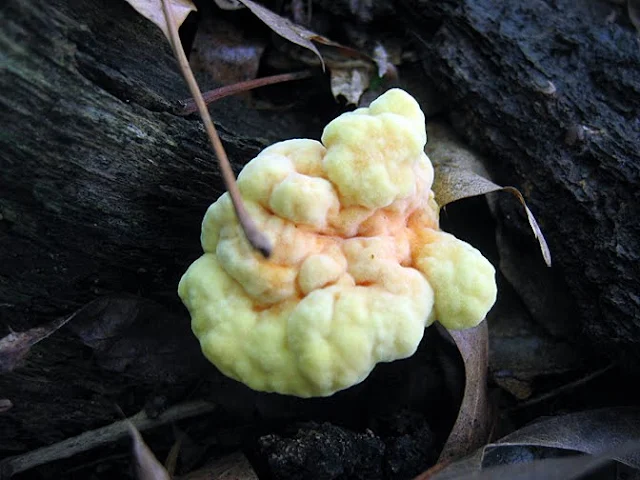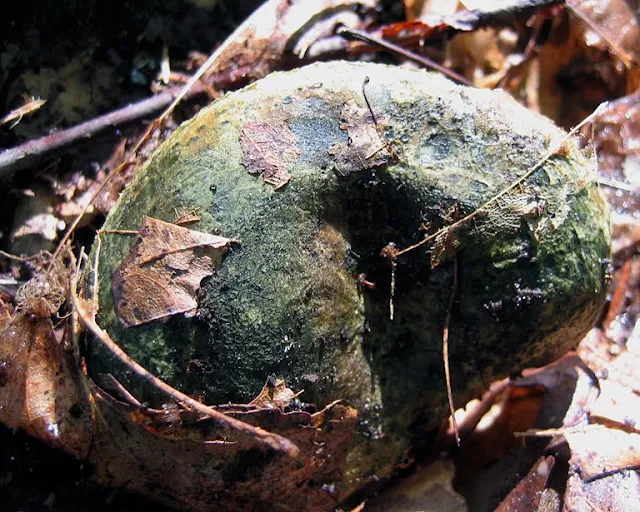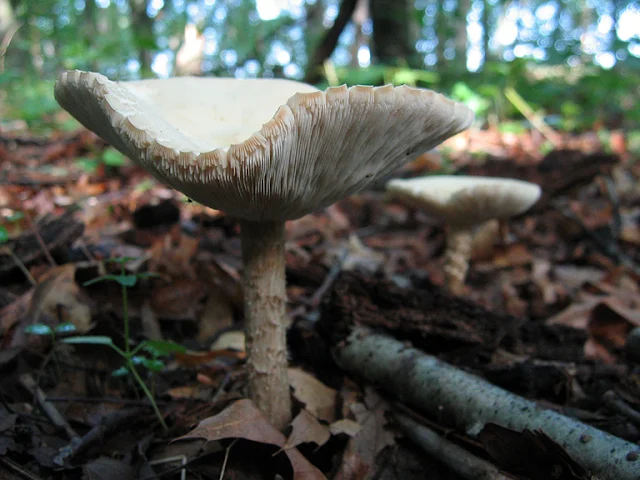Mushroom People
From Letters From The Big Woods...
The phone rang after my return from a sojourn in the woods, Rex answered. "Yes, hmm, yes, right. Okay, well maybe you should talk to my son-in-law Frank," phone and its umbilical cording extended toward me. Hello, this is Frank. "This is Steve, I hear you take photographs of mushrooms." Well, not only mushrooms, but I did take a number right here just a few minutes ago. "Well I belong to a group here called the Minnesota Mycological Society and we're looking for some special mushrooms, particularly the King Bolete." Oh, well I wouldn't know anything about that. "Well, I'll tell you what, we are going on a mushroom expedition about 30 miles north of here, tomorrow at 9 am, and maybe you would like to come along. Okay, I'll check with my wife and see if we have anything planned. I'll get back to you.
Afterward, Rex told us that he had called his friend John to tell him that he had found a sulfur shelf mushroom in the woods and that John had then reported it to his friend Steve -with whom I had just spoke. The sulfur shelf, which I knew nothing of, but imagined like a yellow half-circle on the side of a tree, had long since rotted, but Rex insisted that there were more interesting mushroom finds in his woods. When I walked in from the trail, Rex was on the phone making his best case that the mushroom people should come search on his property.
With a little discussion about the high quantity of mosquitoes and the swampiness of the location, but then the cooler day promised and the best words in the english language, no -ticks are over for the season, we decided we should go along for the ride, see what it's all about. The best part -the opportunity to ID some mushrooms with people who actually know what to look for.
What you should know about mushroom enthusiasts is that they can sometimes be, err, socially awkward. Well, so can I, so what I really mean is secretive. Unfamiliar with the group we were about to meet at the McDonald's off a highway exit ramp, naturally we had to rely on our wits. Hmm, who might the mushroom people be? Those two, they look like mushroom hunters, dressed wrongly for a morning at McDonald's. We walked up to their booth and introduced ourselves, Rex, Betsy, and Frank. They looked at us, said yup, we're the group, but with no names given. Okay, neither is Steve because I heard his voice on the phone. We ordered some funky ass McD breakfast foods and took to our own booth.
A woodsy, but professorial-looking man entered, who turned out to be Steve. He met with his group, and then headed over to our booth, but by this time, the others were rearing to go. Out to the cars then, where we raced off to the secret location -this I assume because it seemed odd to me that we would meet one exit away from our destination, not at the exit of our destination which also had a fast food restaurant. Our trail of cars sped down back roads, over burbling streams, past houses with horses, into an oak woods that looked quite a bit like the oak woods I grew up with on Long Island.
We parked at a small, unpaved, unsigned trail-head. Left our cars to prep for mosquitoes, ticks (why, they're over, I thought), and hiking. Betsy joked that maybe mushroom men are unfriendly because they are insecure about walking around with so many baskets. It was a little funny to see these grown, aging even, men pull all kinds of woven baskets out of their trunks. We, of course, were unprepared for collection, which was their purpose and gave some members a reason to grouse. I explained that I would be collecting pictures of mushrooms, and information, if possible, nothing more.
Ruth and one of the unnamed mushroom people.
It became immediately apparent why baskets are useful to mushroom hunters. Ruth, seen above, tried to carry and protect multiple mushrooms with only one basket. As it turned out, Ruth, who had the most unstable sense of direction and a whistle for 'lost!', was collecting for the Mycological Society's Minnesota State Fair exhibit. It seemed crazy to me that a woman so easily turned around in a woods would also spend her time collecting mushrooms. Her one basket overwhelmed by collection, I offered to carry in hand her specimens of moss-covered bark and mushrooms she intended to use to fill out the exhibition.
A puffball (?)
Steve showing Betsy (in her mosquito net) the finer points of detecting 'ordinary' white mushrooms from the poisonous Amanita bisporiga, or Destroying Angel.

Ruth excitedly displays a Destroying Angel specimen, one of the deadliest mushrooms on Earth. She points out the 'skirt' on the upper stem and the bulbous sheath at the bottom of the stem -both indicating that this mushroom is of the deadly genus Amanita.
The annulus is the 'skirt' in the middle, the volva is the upside down 'mop' at the bottom -both on the stipe (stem). The volva is a remnant of the universal veil that once shrouded the whole fruiting body and the annulus is a remnant of the partial veil that shrouded the gills.

Puffballs, late stage. Also known as 'Wolf Farts,' as described by Tom Volk. Incidentally I had heard one member of the group joking around about "the only professor with blue hair and his heart in a jar." I asked if he was talking about Tom Volk. He looked shocked, briefly -how do I know about this Wisconsin-based professional mycologist? Oh, thank you Internet, for occasionally helping with socializing. I had discovered Tom Volk's website when trying to understand the pthalo blue wood at Weir Farm -his site gave me the answer.

No ID, but a lovely mushroom.


These are choice edible Chantarelles, Cantharellus cibarius.

Notice the buttery orange color and the pseudo gills -flattened and forked running the length of the underside.

This one, hard to say. Kind of waxy, sticky. The 'experts' couldn't say. An old Chantarelle, I wonder?

And that's the problem with eating wild mushrooms -how good are your experts? You want them to be surely sure, really sure.

This was a good looking mushroom. Depressed top, whitish with pinkish splotches.

In profile, the green underside.

And the amazing pattern. No ID.

Turkey tails, or Trametes versicolor.

Something Steve said along the route is useful to remember -there are many, many edible mushrooms, but only so many that you want to eat.
__________________________
For the society mycologists, the mushroom guys, this was a mushroom hunt. We began to feel as if the three of us were viewed as tag-a-longs, which I guess we were, but, it should be understood, were three people comfortable in a woods and unusually observant. The mushroom guys, fast-paced, kept hollaring out that we must keep moving, forge ahead, while our focus was downward, slower, exploratory. The mushroom guys picked mushrooms and tossed them without much sensitivity -these were experts after all, not phased by trampling or other spoils of the hunt.

A tossed mushroom
In fact, I was amazed how the endeavor of hunting mushrooms had little regard for trail rules, how bushwhacking is the norm, how it requires trampling. I suppose the woods is lucky that there are so few mushroom people, which I can only gauge based on the multiple suggestions that we join the society and how few mushroom enthusiasts we actually know. I inquired with Steve about the rules of hunting. How many do you take? "There's an unwritten rule that you pick 1/3 to 1/2 of the mushrooms." But what of the next person who sees only half but regards it as the whole, diminishing the supply by half once again, and so on? "Hard to say." Hmmm, secretive must be the norm.
Betsy had felt that the mushroom guys were dismissive of us, that they were the experts, and accordingly they would find the best mushrooms. That all soured when Betsy had found the Parasol mushroom and had beckoned the experts to her location to name what she had successfully hunted and they had successfully missed.

The Parasol mushroom, Macrolepiota procera, grows tall and slender, with a cap that extends quite large, a true fairy fungus said to resemble a parasol when open. The cap is edible, but should have brown flakes on white. Don't confuse it with the highly poisonous Amanita, who's own flakes are white on brown.

Which is why one's time with mushroom people is very important, because tomorrow's gastronomical choices will be defined by their attentiveness to your questions today. Could that be another reason why mushroom guys may have distanced themselves from a bunch of tag-a-longs -a nagging sense of responsibility?

As the photographer, I was often not in the right place, never fast enough to keep up with the hunt. I would hear "photograph" bounding off trees, and would make my way to that moment's hot location. Occasionally, Steve would point out a mushroom worthy of photography and give me a rough ID, as happened with the above and below yellow Coral Mushroom.


This one was pointed out for its unusual stem, apparently split and hollowed as seen below.


White Coral Mushroom.

I was told this is a young Sulfur Shelf, or 'Chicken of the Woods,' Laetiporus sulphureus. Oh, that's the mushroom that started all of this, the one Rex had seen and reported to his friend, who then called the Steve, who then called Rex.

I wondered what this very green-capped mushroom was.

But no one could be sure, and the mushroom people needed to move on to another location. By this time I think we had had enough and decided, as we hiked back to the cars, to head home. To Ruth's collection we offered our young Sulfur Shelf, Parasol, and Coral mushrooms and she was ever so grateful. What good would keeping them have done us! With the Fair only a day away, she needed as much help as she could get, and still she was without a grand centerpiece.
Rex, always a proud representative of his woods, continued to suggest that the mushroom people come to his place to look for more mushrooms. It was clear to me that the group had little interest in this, so I suggested that we take a look at home and, should we find anything, we would give them a ring and meet halfway to deliver the goods. Good enough, eyeing our generosity with a bit of skepticism -a little cart before the horse. Rex, though, is sure we'll find something for them to show at the Minnesota State Fair -the grandest exposition of all that is vegetable, floral, faunal, even fungal.
We left the mushroom people around noon, headed home, ate some lunch, then Rex and I hit the trail. One of the first things we did was collect a part of the Pear-shaped Puffball colony I previously discovered on some fallen logs.

The best part of this collection of ordinary puffballs was that you could get an excellent view of the mycelium.
Then, doing as mushroom people do, we left the trail and walked along the slopes around the wetland, on the neighbor's property too, into the untamed woods that no one ever seems to explore. We saw hundreds of Indian Pipe clusters, but little in the way of mushrooms. We found two great washouts from recent heavy rains, but then, no great mushrooms. After pausing near a newly fallen oak amongst a field of hogpeanut in the sunshine, we move back towards the property line and decide its a wash -all we have are puffballs.
To Be Continued...







Oh alright. Your mushroom post wins :-)
ReplyDeleteSo, puffball cooking?
You know I've been working on this for friggin two months! And I had to break it up into three post, one yet to come.
ReplyDeleteBut at least you ate your mushrooms! No, we didn't eat the puffs. Not sure why.
This was such an awesome post! I couldn't stop laughing at your anecdotes. It looks like you had quite an adventure. The photos of the mushrooms are gorgeous. It's too bad the mushroom people weren't more sociable or nicer. This is something I would love to do since I'm so fascinated by mushrooms, but I think I would be bummed by the ill-mannered "experts".
ReplyDeleteSteve and Ruth were nice. Maybe I pushed that angle too hard, but then, I tried to play it out in the post that they may have had their reasons for being less than social -responsibility, secret locations, etc.
ReplyDeleteI'm sure a group that wants to educate, will be friendly and willing. You should find one!